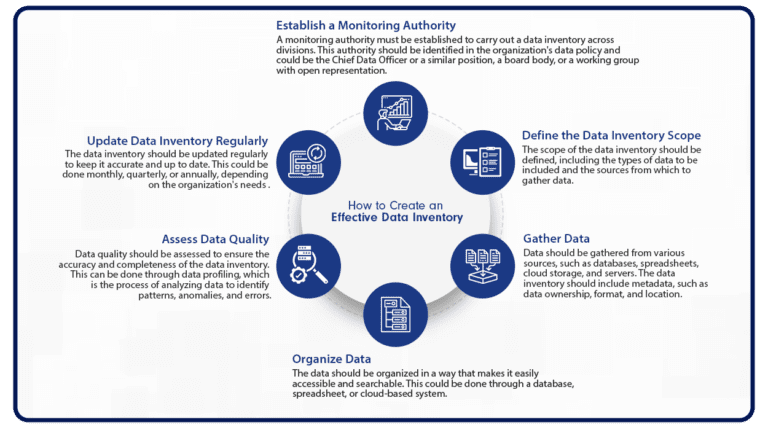Co-Authors:
Devesh Salvi
Product Analyst at Modak
Aastha Jha
Content Manager at Modak
Maintaining an accurate inventory of data is crucial, especially in today's remote work and cloud-based application environment. Organizations today sit on stacks of data, both structured and unstructured, scattered across different locations within the company and in the cloud. Understanding and managing this data is crucial for efficient usage and safeguarding. Having a thorough data inventory is the first step in gaining an understanding of what data an organization owns, where it is located, and how it can be used.
The research firm Gartner predicts that 80% of customers currently do not have an accurate inventory of their data. This underscores the need for organizations to take their data seriously and treat it as a strategic asset.
In this blog, we will explore what data inventory is and how it can benefit an organization’s overall operations and growth.
The research firm Gartner predicts that 80% of customers currently do not have an accurate inventory of their data. This underscores the need for organizations to take their data seriously and treat it as a strategic asset.
In this blog, we will explore what data inventory is and how it can benefit an organization’s overall operations and growth.
What is Data Inventory?
A data inventory is not just a simple list of data assets that an organization maintains. It is a comprehensive and structured document that provides detailed information about each data source and how it is used within the organization. The data inventory includes metadata such as data ownership, format, location, access controls, data classification, and retention policies.
Data classification is a key component of a data inventory. It involves categorizing data according to its sensitivity, importance, and value to the organization. This enables the organization to determine the appropriate level of protection and access controls that should be applied to each type of data. For example, sensitive data such as financial information or personally identifiable information (PII) may require stronger security controls and stricter access restrictions than non-sensitive data.
In addition to the above, a data inventory should also include information about the relationships between different data sources, such as how data flows between different systems, and how it is transformed and processed. This is important for identifying dependencies and ensuring that data is being used appropriately across the organization.
Overall, a comprehensive data inventory is a valuable tool for managing data assets, improving data quality, and minimizing risks associated with data loss, privacy breaches, or non-compliance with regulations. It also helps organizations to make informed decisions about how to use data effectively and strategically to achieve their business objectives.
Data classification is a key component of a data inventory. It involves categorizing data according to its sensitivity, importance, and value to the organization. This enables the organization to determine the appropriate level of protection and access controls that should be applied to each type of data. For example, sensitive data such as financial information or personally identifiable information (PII) may require stronger security controls and stricter access restrictions than non-sensitive data.
In addition to the above, a data inventory should also include information about the relationships between different data sources, such as how data flows between different systems, and how it is transformed and processed. This is important for identifying dependencies and ensuring that data is being used appropriately across the organization.
Overall, a comprehensive data inventory is a valuable tool for managing data assets, improving data quality, and minimizing risks associated with data loss, privacy breaches, or non-compliance with regulations. It also helps organizations to make informed decisions about how to use data effectively and strategically to achieve their business objectives.
Why is Data Inventory Important?
Data has become an asset for organizations, with McKinsey research showing that enterprises that are “datafied” are 23 times more likely to acquire customers, 6 times as likely to retain customers, and 19 times more likely to be profitable (ref here). With the growing number of IT systems, companies may have a low level of awareness about where they house sensitive information. Compiling a data inventory is essential for comprehending the value and whereabouts of an organization's data resources and metadata, which can aid in decreasing risk and guaranteeing conformity with privacy and regulatory requirements.
Data inventory is an important aspect of an organization's data management that provides immediate visibility into all its data sources, the information they acquire, where the data is stored, and what happens to it in the end. In addition to the benefits mentioned earlier, a comprehensive data inventory also helps organizations comply with regulations such as GDPR and CCPA, which require them to know what personal data they hold and how it's being processed.
Data inventory can also help organizations manage risks associated with unauthorized access, data breaches, or data loss by identifying and mitigating potential risks. It is an essential part of data governance, which involves managing data to ensure its accuracy, completeness, consistency, and security. With a data inventory, organizations can ensure that their data is managed according to their data governance policies and standards.
Data inventory is an important aspect of an organization's data management that provides immediate visibility into all its data sources, the information they acquire, where the data is stored, and what happens to it in the end. In addition to the benefits mentioned earlier, a comprehensive data inventory also helps organizations comply with regulations such as GDPR and CCPA, which require them to know what personal data they hold and how it's being processed.
Data inventory can also help organizations manage risks associated with unauthorized access, data breaches, or data loss by identifying and mitigating potential risks. It is an essential part of data governance, which involves managing data to ensure its accuracy, completeness, consistency, and security. With a data inventory, organizations can ensure that their data is managed according to their data governance policies and standards.
What are the Benefits of Data Inventory?
A comprehensive data inventory can provide numerous benefits for organizations, including:
- Revealing the data currently held, including hidden or obscure data.
- Determining the reliability of data sources.
- Identifying sensitive data subject to legal or administrative regulations.
- Locating valuable data that is underutilized or under monetized.
- Recognizing dangerous information is not proportional to the risk.
- Viewing information subject to additional restrictions like legal holds or investigations.
- Defining roles and duties to make wise business decisions about maximizing the value of data, reducing risks, and avoiding legal or regulatory issues.
How to Create an Effective Data Inventory?
To create an effective data inventory, organizations should follow these steps:

Key Takeaways
A thorough data inventory is a crucial resource for enterprises in the complicated and fast evolving data landscape of today. A complete inventory offers a single source of truth that enables organizations to identify sensitive information subject to rules, locate important but underutilized data, assign tasks, and optimize the value of the data while minimizing risks. Organizations can construct an effective data inventory and utilize data as a strategic asset by establishing a monitoring authority, carrying out routine updates, and employing data mapping. Organizations can be better prepared to make data-driven decisions, retain customers, attract new ones, and boost profitability if they have an accurate inventory of their data.
About Modak
Modak is a solutions company that enables enterprises to manage and utilize their data landscape effectively. We provide cloud-agnostic software and services to accelerate data migration initiatives. We use machine learning (ML) techniques to transform how structured and unstructured data is prepared, consumed, and shared.
Modak’s portfolio of Data Engineering Studio provides best-in-class delivery services, managed data operations, data mesh, data fabric, augmented data preparation, data quality, and governed data lake solutions.
Modak’s portfolio of Data Engineering Studio provides best-in-class delivery services, managed data operations, data mesh, data fabric, augmented data preparation, data quality, and governed data lake solutions.
To learn more, please download: https://modak.com/modak-nabu-solution/
Co-Authors:
Devesh Salvi
Product Analyst at Modak
Aastha Jha
Content Manager at Modak



